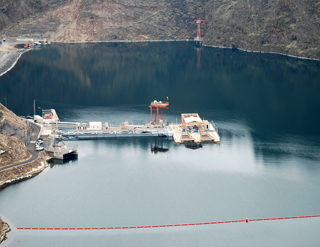National finalist
Gold Award
Project: Pelton Round Butte Selective Water Withdrawal
Client: Portland General Electric

Photo courtesy of CH2M Hill CH2M Hill designed North America’s largest fish-collection system at a hydroelectric plant at the Round Butte Dam in Oregon.
|
Fish migration has become a critical issue in water management facilities in the Pacific Northwest, particularly the protection of salmon during their annual spawning journeys through hydroelectric systems.
One solution for this problem was developed by CH2M Hill for Portland General Electric at the Round Butte Dam, located on the Deschutes River west of Madras, Ore. It is the only hydroelectric project in the United States that is jointly owned by a utility and an American Indian tribe (the Confederated Tribes of the Warm Springs Reservation).
CH2M Hill designed an intake structure at the Round Butte powerhouse to reestablish currents vital to fish migration, restore water quality both upstream and downstream, and — for the first time in more than 40 years — allow chinook, sockeye and steelhead salmon to complete their life cycles in the Deschutes River Basin.
The project, called the Pelton Round Butte Selective Water Withdrawal System, relies on a 2,600-ton floating top structure that draws surface water and collects downstream migrant, and a 700-ton bottom structure attached 270 feet below the surface. The bottom structure controls the release of cold water from deep within the reservoir, allowing the system to meet year-round temperature goals, and at the same time revises surface currents to mimic natural conditions the fish use to find their way downstream.
The 273-foot-tall structure is the first known floating structure that can draw intake water from various depths of its reservoir, collect and sort migrating fish, and provide 100 percent exclusion so that not one fish enters the powerhouse intake. At 3,550 tons, it is also the largest fish-collection system at a hydroelectric plant in North America.
Contributing to the project’s complexity was its location in a steep canyon. Because the workspace was very small, accommodating only a single crane to unload materials, all major components had to be constructed entirely on water.
Everything was assembled on floating construction decks that were designed to be incorporated into the finished structure.